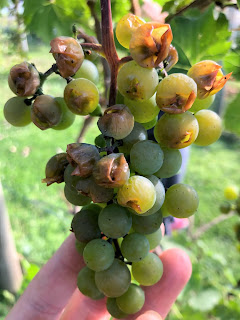 |
| Itasca grape clusters getting ready for harvest in 2019. Photo: Annie Klodd |
Veraison has been spotted on grape clusters from the Horticultural Research Center in Chanhassen to Les Curry's Marquette vines in Amboy. You know what that means: It's almost bunch rot - err, I mean - harvest season!
Key grape bunch rot diseases to look out for in Minnesota include botrytis bunch rot, sour rot, and phomopsis. Another non-disease related fruit disorder to watch for is bunch stem necrosis. It is important to know how to tell these diseases and disorders apart from each other, because the management strategies vary for all of them. This article describes the differences in symptoms and management between botrytis grey mold and sour rot.
Clusters infected with botrytis or sour rot should not be sold or used in wine. Including infected clusters may cause the winery to reject an entire batch of fruit or reduce payment.
Botrytis grey mold (Botrytis bunch rot)
 |
| Botrytis grey mold on a Marquette grape cluster, September, 2019. Photo: Drew Horton |
Fungicides active on botrytis grey mold should have been included in the vineyard's first cover spray after bloom. The Botrytis cinerea pathogen begins actively infecting and reproducing on the flowers during bloom. If your disease spray program did not control botrytis after bloom, those flower infections are still present and can lay dormant and resume activity on the ripening clusters.
Therefore, poor disease management earlier on can cause the disease to manifest during harvest. High humidity, rain, dense canopies, cool temperatures, and wildlife damage during harvest increases the chance of infection.
The most telling characteristic of botrytis on ripening clusters is the gray, fuzzy mold. It often starts on one berry and spreads to more berries on the cluster. Therefore, research has found that tight-clustered varieties are more susceptible to botrytis losses than varieties with looser clusters. Additionally, leaf pulling between bloom and veraison opens up the canopy to airflow and sunlight, reducing the potential for infection.
Harvest-season management of botrytis: Fungicide applications are recommended at the onset of veraison and again 2-3 weeks later, especially if weather conditions are wet and cool as described above or if botrytis has historically been an issue in the vineyard. If weather conditions during this time are dry and warm, fungicide applications can be spaced further apart.
Before spraying, check to make sure that the fungicide you are applying has strong activity on botrytis. Additionally, check the pre-harvest interval and make sure it is labeled for grapes.
Select fungicides that have low risk of resistance and is highly effective on botrytis, and rotate between products with more than one FRAC code, to decrease resistance development. Options include:
- Fludioxonil (i.e. Switch, FRAC 12)
- Fluopyram (i.e. Luna Sensation, Luna Experience, FRAC 7)
- Isofetamid (Kenja, Fervent, FRAC 7)
Do not use strobilurins (Abound, Sovran, Flint, etc.) that only include FRAC 11 for botrytis management, as they only have suppressive activity and are at high risk of fungicide resistance.
Do not use the same FRAC code more than twice in one season. For example, if you applied Switch (FRAC 12) after bloom, you can only use it once more before switching to a product with a different FRAC code, like Fervent (FRAC 7).
Additional fungicide options are listed in this great article from University of Maryland.
Sour rot
 |
| This grape cluster has sour rot that was introduced at the site of bird pecks. Photo: Krista Kopperud. |
Grape growers should do their best to distinguish sour for from botrytis in the vineyard, because botrytis fungicides will not control sour rot. Symptoms of sour rot include a slimy decomposition of the berries and a vinegar smell. It does not produce the gray, fuzzy fungal masses like botrytis. The vinegar smell is not released immediately, so sour rot can be seen before the onset of "vinegar" odors.
Sour rot-infected grapes should not be used in wine because of the off odors and flavors associated with them.
Sour rot is caused by a bacterial infection that is introduced to the berries via fruit flies. Most fruit fly species like Drosophila melanogaster are only attracted to berries that are already injured by things like splitting, birds, hail, etc. They feed on the juice seeping from the injured fruit and introduce bacteria (Acetobacter and Gluconobacter spp.) that create the vinegar smell. Therefore, sour rot is more common where grape injury has occurred. However, spotted wing Drosophila fruit flies (Drosophila suzukii) attempt to pierce the skin of uninjured ripe berries and can cause sour rot in the process.
Since sour rot requires fruit fly infestation, strong sour rot prevention involves the use of an insecticide to control the fruit flies, and a bactericidal product such as OxiDate to dry up the infected fruit. Additionally, take cultural measures like bird net to minimize berry injury. In vineyards prone to sour rot, the spray program should be applied regularly once the berries reach 13-15 brix. More details on application timing and product options are in the webinar recording below.
Researchers at Cornell University and University of Missouri have done extensive research on sour rot to determine best management practices. To learn more about the specifics for how to manage sour rot, please view our UMN/UW Extension webinar recording from July 15, featuring Dr. Megan Hall from University of Missouri:
Author: Annie Klodd, UMN Extension Educator - Fruit and Vegetable Production
Comments
Post a Comment